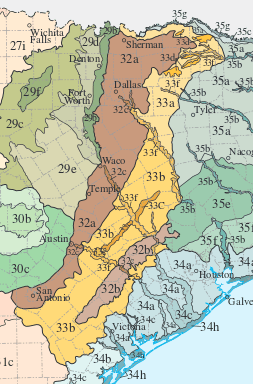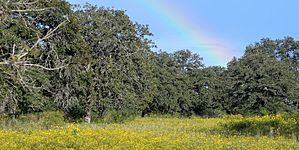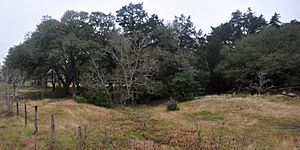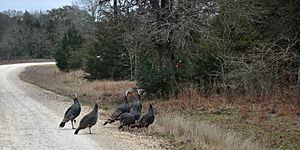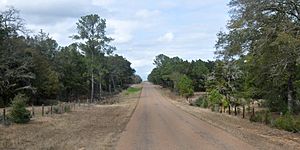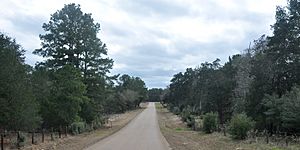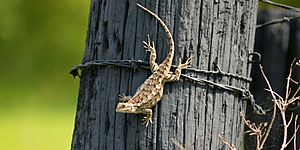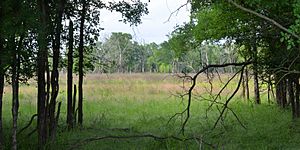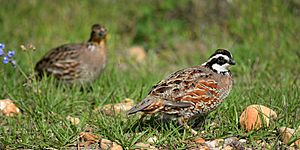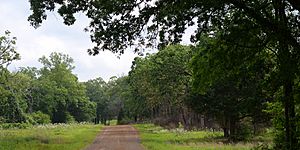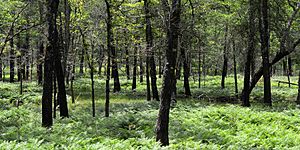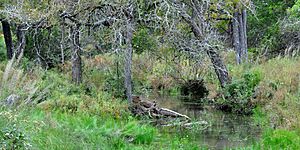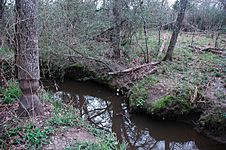East Central Texas forests facts for kids
Quick facts for kids East Central Texas forests |
|
|---|---|
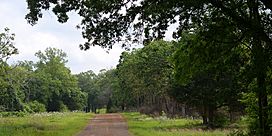
Northern Post Oak savanna, Gus Engeling Wildlife Management Area
|
|

East Central Texas forests (33)
|
|
| Ecology | |
| Realm | Nearctic |
| Biome | Temperate broadleaf and mixed forests |
| Geography | |
| Area | 52,600 km2 (20,300 sq mi) |
| Country | United States |
| State | Texas |
| Conservation | |
| Conservation status | Critical/endangered |
| Habitat loss | 75% |
The East Central Texas forests (also known as Ecoregion 33) is a special natural area. It's mostly found in Texas, United States, but a small part also reaches into southeastern Oklahoma. This area is a type of temperate broadleaf and mixed forests, which means it has a mix of trees that lose their leaves in fall and some evergreens.
Contents
What are the East Central Texas Forests?
The East Central Texas forests are different from nearby areas. They have more trees than the Texas Blackland Prairies, which are mostly grasslands. But they are also more open and have more hardwood trees (like oaks) than the dense Piney Woods to the east. The weather here is usually hot and humid.
Different Parts of the Forests
This ecoregion is made up of several unique smaller areas, each with its own features.
Northern Post Oak Savanna
This part of the ecoregion has mostly flat or gently rolling land. It sits on old rocks from the Eocene and Paleocene periods. The main trees here are post oak, blackjack oak, eastern redcedar, and black hickory. Open areas, called prairies, have grasses like little bluestem and other small plants. Today, much of this land is used for pastures. You might also find some pine trees, especially near the edges of this area. Common animals include white-tailed deer, eastern wild turkey, northern bobwhite, and fox and gray squirrels.
Southern Post Oak Savanna
This area has more woods and forests than the prairies next to it. It has mostly hardwood trees, unlike the pine forests to the east. Historically, it was a savanna with post oak trees. Now, it's a mix of post oak woods, pastures, and rangelands. Some areas have thick bushes like yaupon and eastern redcedar. The ground here has different types of sand and soil. In a few spots, you can find unique bogs (wetlands). The endangered Houston toad lives in the deep, sandy soils of this ecoregion.
San Antonio Prairie
This is a long, narrow strip of land, about 100 miles long. It's mostly found on a type of rock formation called the Cook Mountain Formation. The prairies here used to be covered in grasses like little bluestem and yellow indiangrass. These grasses were different from those found in the Texas Blackland Prairies. People started settling here in the 1830s, especially along the Old San Antonio Road. Today, the land is a mix of woodlands, pastures, and some farms.
Northern Prairie Outliers
These are small, separate areas that combine features from both the Texas Blackland Prairies and the East Central Texas forests. The northern parts are on older rock formations, while the southern parts are on newer ones. Historically, these areas had a mix of forests and prairies. Fires were important for keeping the grassy areas open. Without fires, more trees and bushes started to grow. The tallgrass prairies here included little bluestem, big bluestem, yellow indiangrass, and tall dropseed. Most of this land is now used for pastures and some farming.
Bastrop Lost Pines
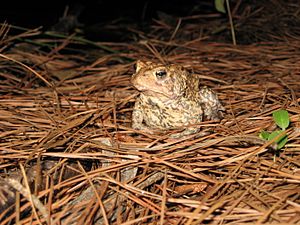
This ecoregion is a special, isolated forest of loblolly pine and post oak trees. It's the westernmost group of southern pine trees in the United States. These pines mostly grow on gravelly and sandy soils that were formed by an ancient Colorado River. The Lost Pines are about 100 miles (160 km) west of the main Texas pine forests and get less rain. The deep, sandy soils and extra moisture from the Colorado River help these pines survive. Scientists believe these trees are a very old population that has been here since before the last ice age. The largest group of Houston toads lives in this ecoregion.
Floodplains and Low Terraces
This ecoregion includes the wide, flat areas along major rivers like the Sulphur, Trinity, Brazos, and Colorado rivers. These areas are made of recent soil deposits from the rivers. The forests here have trees like water oak, post oak, elms, green ash, pecan, and willow oak. In the western parts, you might also see hackberry and eastern cottonwood trees. The northern floodplains have more forests, while in the south, the Brazos and Colorado River floodplains are mostly used for farms and pastures.
Animals of the Forests
These forests are home to many different animals. You can find Virginia opossums, tiny North American least shrews, and North American beavers. Many types of butterflies and reptiles also live here. Some larger animals that used to live in this area, like jaguars and Plains bison, are no longer found here. Sadly, some animals in this ecoregion are endangered, meaning they are at risk of disappearing forever. These include the Houston toad and Attwater's prairie chickens.
Protecting the Forests
This natural area has changed a lot over time. A lot of the original forests have been cleared for cattle ranches and farms. Now, only about a quarter of the original habitats are left. These remaining areas are often small and spread out, not in large, connected blocks. There are no big national forests in this region to protect these habitats.
Images for kids
-
Oaks trees (Quercus) and wildflowers, Nockenut Road, Guadalupe County, Texas, USA (6 October 2018).
-
Wild Turkey (Meleagris gallopavo) Kuykend Road, Austin County, Texas, USA (30 January 2014).
-
Texas spiny lizard (Sceloporus olivaceus) on a fencepost, Highway. 102, Colorado County, Texas, USA (26 March 2017).
-
Lake Somerville State Park. Lee County, Texas, USA (11 May 2017).
-
Lake Somerville State Park, Flag Pond area, Lee County, Texas, USA (11 May 2017).
-
Lake Somerville State Park, Lee County, Texas, USA (3 May 2019).
-
Northern Bobwhite (Colinus virginianus), male right, female left, Colorado County, Texas, USA (17 March 2017).
-
Signs of beaver (Castor canadensis) activity, gnawed tree trunk (lower left) and burrowing in stream bank. Private land, Madison County, Texas, USA. (12 March 2010).


